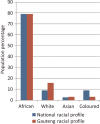Analysing post-apartheid gender and racial transformation in medical education in a South African province
- PMID: 23364091
- PMCID: PMC3556715
- DOI: 10.3402/gha.v6i0.19810
Analysing post-apartheid gender and racial transformation in medical education in a South African province
Abstract
Introduction: In light of global concerns about insufficient numbers of doctors, midwives, and nurses, the World Health Organization (WHO) has identified the scale-up of the production of medical professionals who are competent and responsive to community needs as urgent and necessary. Coincident with this imperative, South African medical schools have also had to consider redressing apartheid-era inequities in access to medical education and changing the racial and gender profile of medical graduates to be representative of the population. In this article, we explore progress and challenges with regard to transformation, defined as intentional and planned changes aimed at addressing historical disadvantages, in the Gauteng Province of South Africa.
Methods: A cross-sectional, descriptive analysis was conducted using data on medical school admissions and graduations from the Health and Education Departments for the period 1999-2011. Admission and graduation statistics of 1999, 2005, 2008, and 2011 were analysed according to race and gender.
Results: The results show that there has been progress in transforming the race and gender composition of medical students and graduates, in line with the transformation strategies of the South African government. In 1999, black African enrolments and graduates were conspicuously low in two of the three medical schools in the Gauteng province. By 2011, an almost six-fold increase in black African student enrolments was seen in one medical school that was previously designated as a white institution. In contrast, at the historically black medical school, whites only represented 0.40% of enrolments in 1999 and 7.4% in 2011. Since 1999, the number and proportion of female medical enrolments and graduates has also increased substantially.
Conclusion: While there has been progress with redressing historical disparities and inequities in terms of race and gender, further efforts are needed to ensure that student intakes and graduations are in line with the South African population profile.
Keywords: gender; inequalities; medical education; race; transformation.
Figures
Similar articles
-
Progress in transforming a health sciences postgraduate cohort in a south african research-intensive institution, 2008-2017.BMC Med Educ. 2023 Oct 3;23(1):721. doi: 10.1186/s12909-023-04691-6. BMC Med Educ. 2023. PMID: 37789324 Free PMC article.
-
Doctor retention and distribution in post-apartheid South Africa: tracking medical graduates (2007-2011) from one university.Hum Resour Health. 2019 Dec 16;17(1):100. doi: 10.1186/s12960-019-0439-4. Hum Resour Health. 2019. PMID: 31842879 Free PMC article.
-
Apartheid and medical education: the training of black doctors in South Africa.Int J Health Serv. 1983;13(1):131-53. doi: 10.2190/FCEQ-9W7L-WD9P-5CP9. Int J Health Serv. 1983. PMID: 6832870
-
Medical education, reflections and perspectives from South Africa: a review.BMC Med Educ. 2025 Mar 12;25(1):370. doi: 10.1186/s12909-025-06910-8. BMC Med Educ. 2025. PMID: 40075353 Free PMC article. Review.
-
The use of 'racial' categories in contemporary South African health research. A survey of articles published in the South African Medical Journal between 1992 and 1996.S Afr Med J. 1997 Dec;87(12):1671-9. S Afr Med J. 1997. PMID: 9497832 Review.
Cited by
-
Building new knowledge: celebrating the Wits School of Public Health (WSPH).Glob Health Action. 2013 Jan 24;6:1-5. doi: 10.3402/gha.v6i0.20241. Glob Health Action. 2013. PMID: 23472993 Free PMC article. No abstract available.
-
Socio-economic characteristics and career intentions of the WiSDOM health professional cohort in South Africa.PLoS One. 2019 Oct 21;14(10):e0223739. doi: 10.1371/journal.pone.0223739. eCollection 2019. PLoS One. 2019. PMID: 31634904 Free PMC article.
-
Effects of Gender and Country of Training on Perceived Access to Opportunities for Neurosurgical Research and Gender-Concordant Mentorship.World Neurosurg. 2025 Jan;193:492-510. doi: 10.1016/j.wneu.2024.09.016. Epub 2024 Sep 10. World Neurosurg. 2025. PMID: 39265934 Free PMC article.
-
A self-assessment study of procedural skills of doctors in peri-urban district hospitals of Gauteng, South Africa.Afr J Prim Health Care Fam Med. 2019 May 28;11(1):e1-e8. doi: 10.4102/phcfm.v11i1.1975. Afr J Prim Health Care Fam Med. 2019. PMID: 31170795 Free PMC article.
-
Medical school selection is a sociohistorical embedded activity: A comparison of five countries.Med Educ. 2025 Jan;59(1):46-55. doi: 10.1111/medu.15492. Epub 2024 Aug 9. Med Educ. 2025. PMID: 39119835 Free PMC article. Review.
References
-
- Woollard RF. Caring for a common future: medical schools’ social accountability. Med Educ. 2006;40:301–13. - PubMed
-
- Frenk J, Chen L, Bhutta ZA, Cohen J, Crisp N, Evans T, et al. Health professionals for a new century: transforming education to strengthen health systems in an interdependent world. Revista Peruana de Medicina Experimental y Salud Pública. 2011;28:337–41. - PubMed
-
- World Health Organisation. Transformative scale up of health professional education [Internet] Geneva: Switzerland: 2011. Available from: www.who.int/hrh/resources/transformativeeducation/en/index.html [cited 12 September 2012]
-
- Aina TA. Beyond reforms: the politics of higher education transformation in Africa. Afr Stud Rev. 2010;53:21–40.
-
- Maassen P, Cloete N. Global reform trends in higher education. Transform Higher Educ. 2006;10:7–33.
MeSH terms
LinkOut - more resources
Full Text Sources
Other Literature Sources


